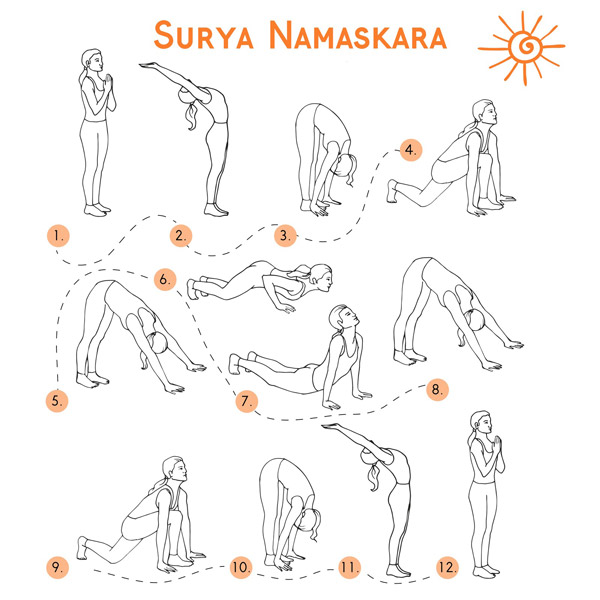Close your eyes for a moment and imagine a yogi in practice. What do you notice? When I do this, no matter which yogic posture comes to mind, I always conjure up an image with the sun in the background. It seems natural that yoga and the sun go together.
Perhaps that’s why the Sun Salutation, Sūrya Namaskār in Sanskrit, is so popular. The sun’s daily appearance renews our energy. It inspires us to awaken and move. We expect good things to happen with the dawn of each new day.
When the natural rhythm of our daily lives moves gracefully from one activity to another, we call it a flow. Similarly, in a hatha yoga practice, a smooth transition from one pose to another is called flow—or vinyāsa in Sanskrit. Vinyāsa, literally translated, means “an arrangement or composition.” All the common terms—series, vinyāsa, and flow—are interchangeable. They refer to a sequence of poses that work well together.
It’s not clear when the practice of arranging classic yoga postures into a sequence began. However, its popularity is easy to understand. Vinyāsas are easy to learn and pleasant to perform. They have many benefits.
The Benefits of Sun Salutation
Yoga postures practiced in a gentle flow are an excellent way to add variety to your practice. The Sun Salutation is a traditional mainstay of many yogis. This vinyāsa is appropriate for both beginners and long-time yogis.
Although gentle, Sūrya Namaskār has a direct effect on our physical and mental well-being. The stretching and strengthening actions increase blood and lymph circulation, which boosts our immune system. The gentle movements lubricate our joints, and the effects are lasting.
You’ll discover mental alertness and clarity through any vinyāsa practice. The practice, along with attentive breath work, demands focus. This ability to focus carries over to other activities. We discover increased self-awareness and confidence.
Finally, Sun Salutation is an energizing exercise. Some yogis even replace their morning cup of coffee with this invigorating practice!
How to Learn the Sun Salutation
Always approach a new exercise regime sensibly. Start slowly. In time, you’ll discover the trusty guide of your body’s intelligence. It will tell you when and how much to increase repetitions and intensity. The Sun Salutation may be modified according to your experience or fitness level.
Learn from a Teacher: The best way to learn yoga postures is from a qualified teacher. They are trained in proper technique and can suggest variations for your particular needs.
Self-teaching: In the absence of a qualified teacher, you can learn Sūrya Namaskār on your own. Many hatha yoga books contain illustrations. Others give detailed instructions on the individual poses.
Recommended Resource for Sun Salutation
Plenty of free videos are available online—in fact, too many! I spent hours reviewing yoga videos to recommend one to you. Many different styles of the Sun Salutation can be found. Most are not suitable for beginners. However, I did discover one excellent free online video. Its presentation is pleasing and provides safe and proper instruction.
This is my recommendation: Yoga for Absolute Beginners: Sun Salutations. The instruction is clear and safe to follow. Please take the time to watch this video once, all the way through, before joining in.
In addition, the diagram below might prove helpful as you begin to learn and practice the series of movements.
When to Practice Sun Salutation
Sun Salutation may be done at any time. However, there are good reasons to begin your day with it. For example, having slept well, your energy is sufficient for several repetitions. And morning’s empty stomach is a boon to an active practice.
Early morning is the traditional time to practice Sūrya Namaskār. But you might not enjoy such rigorous movement then. Your body clock might prefer exercise later in the day. In that case, there are other good options. Try practicing in the afternoon or early evening. You’ll still realize its benefits.
You might wish to try this vinyāsa before your meditation practice. It helps you focus and remain alert. Or perhaps you’ll perform the Sun Salutation after meditation to transition into the rest of your day.
Sūrya Namaskār is not advised immediately before bedtime. Its movements are invigorating and might affect your ability to fall asleep.
Make a Commitment to Start Today
Whenever or for whatever reason you do yoga’s Sun Salutation, you will benefit. Why not start today, right now? Click the link for the video above and start watching. Then, get on your mat and start moving. You’ll be glad you did!
Chityānanda has been a disciple of Svāmī Gurupremānanda Sarasvatī since 1975. She teaches meditation and yoga as a spiritual path in Santa Cruz, California.



Connect With Us